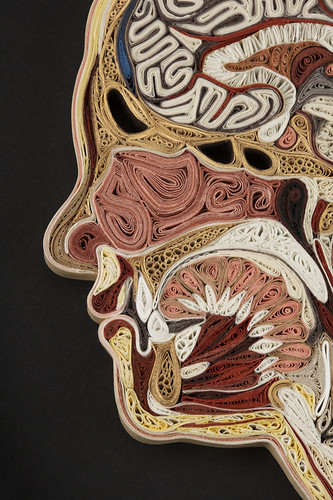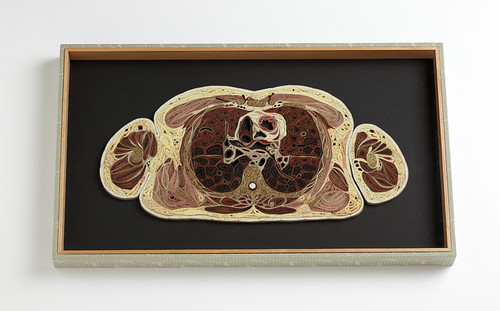Before the internet, most of us didn't know anyone else who quilled... now it's a breeze to chat with, and learn from, many others on a daily basis. A few weeks ago a quilling friend from far away Romania sent me the link to an interview with Lisa Nilsson, a Rhode Island School of Design graduate who lives right here in the northeastern U.S. Lisa's Tissue Series was exhibited last summer at a Massachusetts gallery, and featured quilled human anatomy cross sections displayed in silk covered, wooden boxes she made by hand.
head profile - detail
I wrote to Lisa to ask if she would share her thoughts on quilling and the process.
I had been aware of quilling growing up in the 70s, but hadn't considered it as part of my art making vocabulary until seeing a religious reliquary in an antique store. The first small quilled pieces I made were included in some box-type assemblages I had been making.
 head - cross section
head - cross section
My interest in quilling is mainly in its compatibility with what I see in anatomical cross sections. There is a strong thread of interest in the intricate, time-consuming, and the detailed in my art making, but I make periodic shifts in materials and techniques. The last piece I made was of a cross section of praying hands... I like the idea of recognizable gestures as an area to explore.
 head - detail
head - detail
What is your tool of choice for quilling?
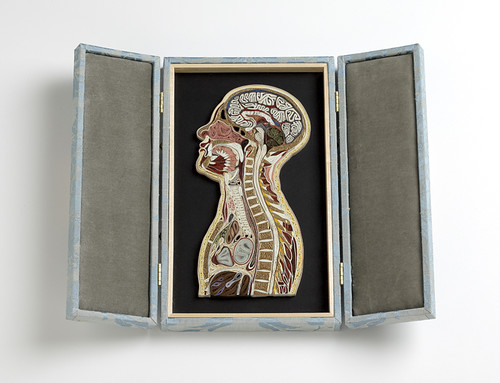 head and upper torso - profile
head and upper torso - profile
I'll use anything close to hand that gets the job done - pins, needles, dowels, drill bits. I have a bona fide quilling tool, but often I don't like the little initiating crimp it makes in the paper, so I usually opt for a pin or needle.
I've been experimenting with some of my husband's 8mm film editing stuff (not entirely satisfactorily) to roll some of the shapes that start with a very long - twenty feet or so- strip (I glue together smaller strips) that is loosely rolled, then folded in on itself. (Makes a great shape for brain tissue!)
thorax - detail
I have a burnishing tool that was made either for dentistry or for press type that is fabulous for pressing small pieces against other pieces that are already in place, much in the way you'd use the surface of your fingernail - though more precisely. Bone folders used for book making often come in handy too.
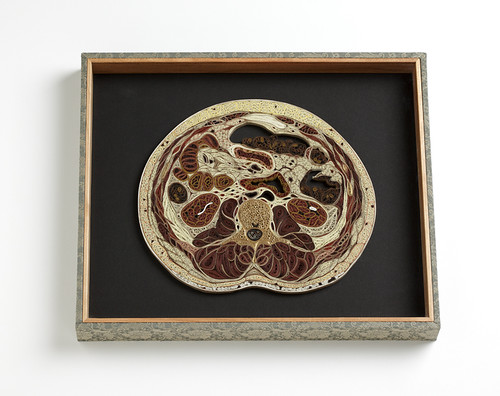 abdomen - cross section
abdomen - cross section
I like to work with Japanese mulberry paper for its strength, flexibility, and the colors available, but that means cutting the strips myself.
The attention to detail in Lisa's work is quite incredible, and I like that she also uses gilded paper cut from the edges of book pages, just as the earliest quillers did.
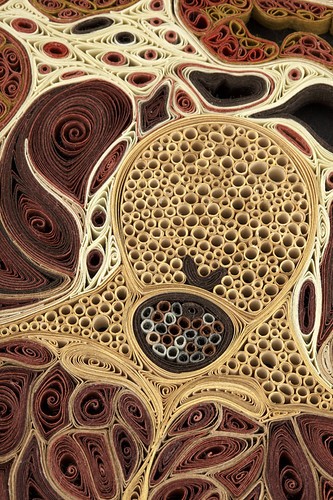 abdomen - detail
abdomen - detail
Some of you may recall the
anatomical series Sarah Yakawonis quilled that was featured here last year. A coincidence that Lisa has created a similarly themed collection? I find it unlikely that any artist would invest hundreds of hours on such an enormous project with the intention of stepping into the limelight of another. Just a few days ago, maker/blogger Pam Harris perceptively showed that through the ages, humans have often conceived of similar ideas independently. Her post [no longer available] brings clarity to the issue that comes up frequently now that images are so readily shared online.
Photography credit: John Polak

